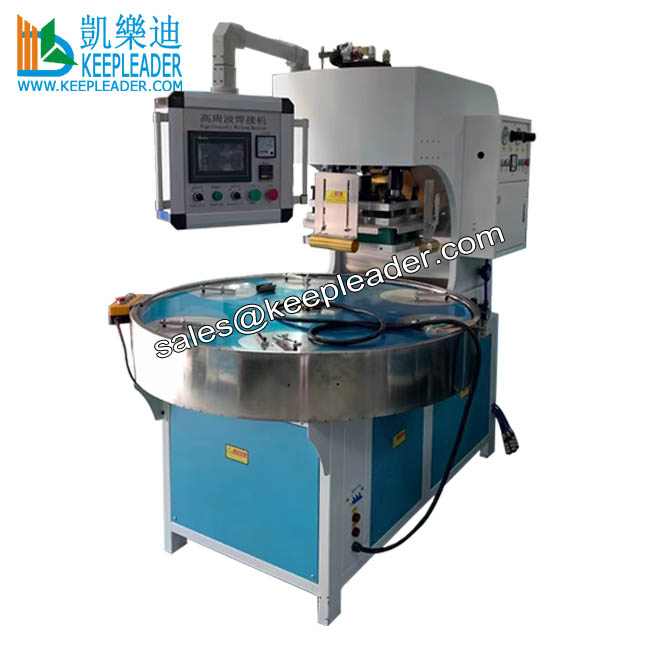Possibility guidance of RF/HF weldable material in High Frequency Plastic Dielectric Welding Machine
High Frequency Plastic Dielectric Welding Machine, a form of dielectric heating, is one of the most widely used methods for assembling thermoplastic flexible products, the process offers consistent quality,thin, strong weld lines, short sealing circles for high output, minimal thermal distortion of the film or substrate, and the ability to produce weld-edge tear seals, of these, the most important advantage is extremely thin weld seams, impulse welding and hot-bar sealing produce a seal area that is about 3mm width, too wide for some medical application, for applications such as containers, the width of the seam is not significant, but for implantable medical device, a thinner seam is preferred, High Frequency Plastic Dielectric Welding Machine has versatile applications, such as industrial, aerospace, aviation and medical device
The materials to be joined by High Frequency Plastic Dielectric Welding Machine must be poor conductors of electricity, since a good conductor would act as a short circuit, weakening the field near the conductor,polyethylene, polypropylene, polystyrene,silicone, and rubber are among the materials that are not responsive to the process, polymers with strong dipole response to the High Frequency Plastic Dielectric Welding Machine, the process has been used to join flexible PVC for many years, its use with polyurethane films, however, is relatively new development
High Frequency Plastic Dielectric Welding Machine process generates radio-wave power, which produces adequate heat to melt plastic materials and produce a free exchange of molecules, thereby bonding materials, AC power is converted to a high-voltage DC current, which an oscillator or resonator outputs as an alternating current, although dielectric heating can be performed at frequencies from 10 to 100Mhz, the radio frequency most commonly used in the industrial fields is 27.12Mhz
An interchangeable electrode, or die, machined in the shape of the part to be welded, is used to apply power to the working-piece, such electrodes are commonly made of brass, since the metal transfers heat evenly, the electrode is pressed against the part, and high-intensity alternating field is directed through the materials, the degree of polarization and energy required to achieve it control the loss factor or dissipation factor of a material, a material that is readily polarized by a small electric field has a high loss factor and is easy to heat, if the polarizing field changes direction at a high frequency, a considerable amount of energy, in the form of heat, can be imparted to each molecule of the material,following table has referential records
| Possibility guidance of RF/HF weldable material in High Frequency Plastic Dielectric Welding | ||
| Material | Loss Index | Response
(G=good,F=fair,P=poor,N=none |
| ABS Polymers | 0.025 | F-P |
| Acetal resin | 0.025 | F-P |
| Cellulose acetate | 0.15 | F |
| DAP | 0.04 | F |
| Epoxy | 0.12 | F |
| Melamine | 0.2 | G |
| Phenal formaldehyde | 0.2 | G |
| Polyamide/PA/Nylon | 0.16 | F |
| Polycarbonate/PC | 0.03 | F-P |
| PVDF | 0.04 | F |
| Polyester/PET | 0.05 | F |
| Polyethylene/PE | 0.0008 | N |
| Polyimide/PI | 0.013 | P |
| PMMA | 0.09 | F |
| Polypropylene/PP | 0.001 | N |
| Polystyrene/PS | 0.001 | N |
| PTFE | 0.0004 | N |
| FEP | 0.001 | P |
| PVDF | 0.05 | F |
| PU film/foam | 0.4 | G |
| PVC film, flexible | 0.4 | G |
| TPE | 0.13 | F |
| Silicone | 0.009 | P-N |
During process of High Frequency Plastic Dielectric Welding Machine, molecules within the material are agitated and move rapidly in a lateral direction, trying to align with the changing electric field, as a result, heat is generated within the material, allowing for excellent uniformity and remarkable speed of heating, the heat produced is highest at the interface of the two components being joined, with other methods, such as thermal sealing and impulse welding, the outside layers of the plastic that touch the dies are the hottest areas, which can result in degradation of film surfaces
When the power to the RF energy generator is shut off. The melted plastic re-solidifies, resulting in a uniform weld that is as strong or stronger than the materials being bonded together, the entire process can take from a fraction of a second to several seconds, depending on the polymer, film thickness, and size of the welding zone
Tooling for the process of High Frequency Plastic Dielectric Welding Machine consists of an upper die mounted to an aluminum tool and jig plate and a bottom die or nest, typically made of aluminum, however, any metal that conducts electricity will work, tooling with rounded welding lines provides a stronger seal that straight lines, shape edge and corners are not desirable since voltage rises when it is applied to corners and shape edges, this can increase the likelihood of arcing, which can damage the film as well as the die
☺ Attn: MS Helen
✉ E-mail:sales@keepleader.com
☎ Cellphone: +86 13590415784 (Wechat/Whatsapp)
☎ Tel: +86 755 84190358
☞ Website: www.hfwelds.com / www.keepleader.com
Post time: Feb-09-2022

